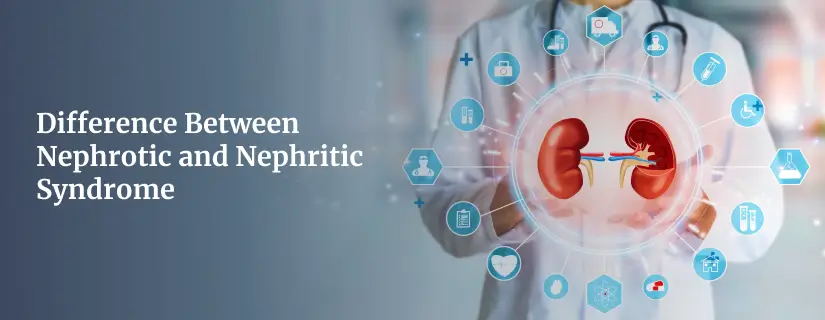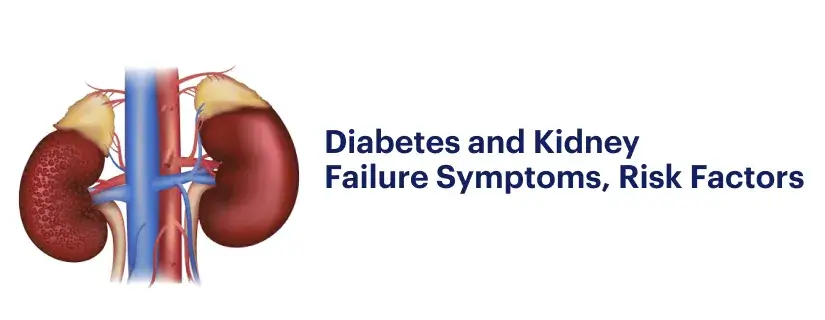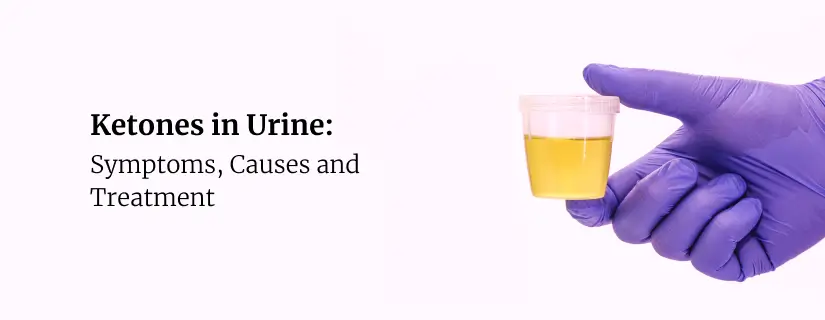-
Doctors
-
Specialities & Treatments
Centre of Excellence
Specialties
Treatments and Procedures
Hospitals & Directions HyderabadCARE Hospitals, Banjara Hills CARE Outpatient Centre, Banjara Hills CARE Hospitals, HITEC City CARE Hospitals, Nampally Gurunanak CARE Hospitals, Musheerabad CARE Hospitals Outpatient Centre, HITEC City CARE Hospitals, Malakpet
HyderabadCARE Hospitals, Banjara Hills CARE Outpatient Centre, Banjara Hills CARE Hospitals, HITEC City CARE Hospitals, Nampally Gurunanak CARE Hospitals, Musheerabad CARE Hospitals Outpatient Centre, HITEC City CARE Hospitals, Malakpet Raipur
Raipur
 Bhubaneswar
Bhubaneswar Visakhapatnam
Visakhapatnam
 Nagpur
Nagpur
 Indore
Indore
 Chh. Sambhajinagar
Chh. SambhajinagarClinics & Medical Centers
Book an AppointmentContact Us
Online Lab Reports
Book an Appointment
Consult Super-Specialist Doctors at CARE Hospitals
Difference Between Nephrotic and Nephritic Syndrome
Updated on 4 December 2023

Kidney diseases can manifest in various forms, each with its own unique set of symptoms, causes, and treatments. Two common renal conditions that often lead to confusion due to their similar-sounding names are nephrotic syndrome and nephritic syndrome. While both involve the kidneys and can cause urinary problems, they are distinct in their manifestation, underlying causes, and management.
Let’s learn the difference between nephrotic and nephritic syndrome in detail.

What is Nephrotic Syndrome?
Nephrotic syndrome is a kidney disorder that makes your body excrete an excessive amount of protein in your urine. It is characterised by a group of symptoms indicating severe kidney damage. It primarily affects the Glomeruli, the tiny blood vessels in the kidneys responsible for filtering waste and excess fluids from the blood to form urine. When the glomeruli are damaged, they allow essential proteins to escape into the urine, causing various problems. This medical condition results in swelling, especially in the ankles and feet, and raises the possibility of further health issues. The risk of blood clots and infections can both rise with nephrotic syndrome. To avoid difficulties, the doctor may advise taking certain drugs and changes in the patient's diet.
Symptoms of Nephrotic Syndrome
Typical signs of nephrotic syndrome include:
- Proteinuria - The hallmark symptom of nephrotic syndrome is proteinuria, which refers to the excessive loss of protein in the urine. Erythema, or the build-up of fluid in the body's tissues, is caused by a drop in blood pressure brought on by the loss of protein, primarily albumin. This swelling can be observed in the face, legs, and abdomen.
- Hypoalbuminemia - Due to the loss of albumin, a protein that helps maintain blood volume and prevent fluid from leaking out of blood vessels, individuals with nephrotic syndrome often experience Hypoalbuminemia.
- Hyperlipidemia - The liver responds to decreased blood proteins by producing more lipids (fats). It leads to high cholesterol and triglyceride levels in the blood.
- Swelling - Edema, or swelling, is a common symptom in nephrotic syndrome. It can affect the ankles, legs, feet, and even the face, causing puffiness and a characteristic appearance.
- Fatigue & weakness - The loss of essential proteins and the increased workload on the kidneys can result in fatigue and general weakness.
Loss of vitamins and minerals, such as calcium and vitamin D, vital to your growth and well-being, is another sign of nephrotic syndrome. It might inhibit the growth of kids with nephrotic syndrome. Osteoporosis, which can be a result of nephrotic syndrome, is a medical condition that can weaken the nails and hair.
What is Nephritic Syndrome?
Nephritic syndrome, on the other hand, is a different kidney condition that also predominantly affects the glomeruli but appears with a unique set of symptoms. Nephritic syndrome is characterized by inflammation and damage to the glomeruli, leading to issues related to blood filtration and immune system activation. Since it usually affects the glomerulus, it is referred to as Glomerulonephritis. The symptoms of glomerulonephritis include glomerular basement membrane weakening and inflammation, as well as the development of tiny holes (pores) in the glomerulus's podocytes. These pores enlarge to the point that they can let both proteins and red blood cells flow into the urine. Low blood albumin levels are a symptom of nephritic syndrome, which is caused by the protein migrating from the circulation into the urine.
Symptoms of Nephritic Syndrome
Common nephritic syndrome symptoms include oedema, or swelling of the face or feet, blood in the urine, and less pee than usual. Depending on whether the acute or chronic form of the condition is present, the symptoms of nephritic syndrome vary.
Acute nephritic syndrome symptoms include:
- Haematuria - Haematuria, or blood in the urine, is a primary symptom of nephritic syndrome. This blood in the urine can be visible to the naked eye or detected only through microscopic examination.
- Hypertension - The inflammation and damage to the glomeruli in nephritic syndrome can lead to high blood pressure (hypertension), a common symptom of this medical condition.
- Proteinuria - While nephritic syndrome can also cause proteinuria, it is usually less severe than in nephrotic syndrome. The primary focus of nephritic syndrome is the presence of red blood cells and inflammatory components in the urine.
- Low amount of urine - Reduced urine output, known as oliguria, is another symptom of nephritic syndrome. The kidneys' decreased ability to filter blood efficiently can result in a reduced volume of urine.
- Swelling - Oedema is less pronounced in nephritic syndrome compared to nephrotic syndrome. In nephritic syndrome, swelling tends to be more localised, often affecting the face and legs.
- Weakness, fever, and exhaustion
- Loss of appetite, nausea, and pain in the abdomen
There may also be nausea and malaise, a general sense of being sick.
The symptoms of chronic nephritic syndrome are typically relatively modest or even undetectable and might include:
- Hypertension, or elevated blood pressure
- Swelling
- Kidney failure in later stages
The urine in both chronic and acute nephritic syndromes frequently contains large percentages of red blood cells since the blood cells seep out of the injured glomeruli.
What is the difference between Nephrotic and Nephritic syndrome?
This table compares essential aspects of Nephrotic Syndrome with Nephritic Syndrome.
|
Aspects |
Nephrotic Syndrome |
Nephritic Syndrome |
|
Underlying Pathology |
Nephrotic syndrome primarily results from damage to the glomeruli, leading to increased permeability and significant proteinuria. |
Nephritic syndrome is characterised by inflammation and immune system activation within the glomeruli, leading to haematuria and reduced blood filtration efficiency.
|
|
Causes |
Diabetes, lupus, infections, and some medications. |
Autoimmune diseases, infections, and some medications. |
|
Symptoms |
Body swelling, frothy urine, lethargy, and weight gain are all symptoms. |
Blood in the urine, elevated blood pressure, reduced urine production, and body swelling are all symptoms. |
|
Proteinuria |
The nephrotic syndrome presents with massive proteinuria, particularly albuminuria, resulting in a significant loss of proteins in the urine. |
While nephritic syndrome can also cause proteinuria, it is less pronounced than in nephrotic syndrome and is often accompanied by haematuria. |
|
Treatment |
Medication and dietary adjustments to minimise oedema and cholesterol levels. |
Medications for blood pressure regulation and treatment of underlying illnesses or disorders. |
|
Complications |
Patients with nephrotic syndrome are more likely to develop infections, thrombosis, and malnutrition owing to protein loss in the urine. |
Patients with nephritic syndrome are at a greater risk of hypertension, renal failure, and end-stage renal disease. |
Conclusion
Nephrotic and nephritic syndromes are two distinct kidney disorders with varying underlying pathologies and symptoms. These medical conditions, although both affecting the kidneys and causing glomerular damage, have specific characteristics. Nephrotic Syndrome is distinguished by severe proteinuria, significant oedema, and typically normal blood pressure, whereas Nephritic Syndrome is characterized by haematuria, hypertension, and mild glomerular injury.
The difference between nephrotic and nephritic syndrome allows for precise diagnosis and tailored treatment options, emphasising the necessity of early identification and good care for better kidney health.

ENQUIRY FORM
SELECT CATEGORIES
-
Neurosciences (16)
-
Neurology (37)
-
Neurosurgery (14)
-
Orthopaedics (48)
-
Oncology (33)
-
Obstetrics and gynecology (52)
-
Pulmonology (23)
-
Urology (20)
-
Nephrology (13)
-
Psychiatry (7)
-
Dietetics and Nutrition (111)
-
General Medicine (63)
-
Cardiac Sciences (32)
-
Vascular & Endovascular Surgery and Interventional Radiology (15)
-
Gastroenterology (46)
-
Endocrinology (23)
-
Plastic Surgery (10)
-
Critical Care Medicine (5)
-
COVID-19 (16)
-
Dermatology (16)
-
Emergency Care (1)
-
Ophthalmology (4)
-
Pediatrics (14)
-
Laparoscopic and Bariatric Surgery (8)
-
ENT (15)
-
Kidney Transplant (1)
-
Liver Transplantation and Hepatobiliary Surgery (5)
-
General Surgery (3)
-
Internal Medicine (5)
-
Medicine Information
Why is Kidney Health Important for Your Entire Wellness?
Kidney Infection: Symptoms, Causes, Diagnosis, Treatment and Prevention
YOU MAY ALSO LIKE
RECENT BLOGS
-

Preterm Birth (Premature Birth): Symptoms, Causes, Treatment and Prevention
13 May 2025
Read More
-

Rotablation Angioplasty: Benefits, Treatments, And Recovery Time
9 May 2025
Read More
-

What Is The Difference Between IUI and IVF?
9 May 2025
Read More
-

Venous Malformations: Causes, Symptoms, and Treatment
30 April 2025
Read More
-

Varicose Vein Foam Sclerotherapy: Treatment, Benefits, and Procedure
30 April 2025
Read More
-

Radiofrequency (RF) Ablation Treatment for Varicose Veins: Know More
30 April 2025
Read More
-

Varicose Vein Sclerotherapy: Treatment, Benefits, and Procedure
30 April 2025
Read More
-

Varicose Vein Endovenous Laser Ablation: Procedure, Benefits, Risks
30 April 2025
Read More
Have a Question?
If you cannot find answers to your queries, please fill out the enquiry form or call the number below. We will contact you shortly.











